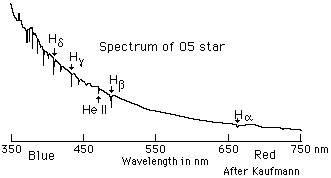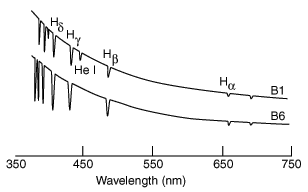O-Type Stars
Included are blue stars with surface temperatures of 20,000 to 35,000K. The thermal energy is so great at these temperatures that most surface hydrogen is completely ionized so hydrogen (HI) lines are weak. Unionized helium (HeI) is visible but the stronger spectra are of mulitple ionized atoms (HeII, CIII, NIII,OIII,SiV). Note the rise of the spectral curve toward the blue from the blackbody radiation curve.
| The radiation rises in intensity toward the blue end of the spectrum. The blackbody peak will be in the ultraviolet. Note that the hydrogen spectrum is seen, but it is red-shifted from its laboratory wavelength of 656 nm. | 
|
| More detail on O-type stars | Star spectral classes |
Star concepts
Reference
Kaufmann
| HyperPhysics***** Astrophysics | R Nave |
